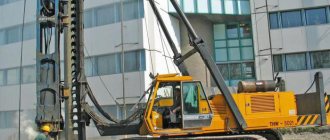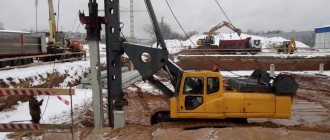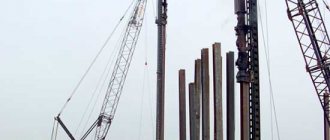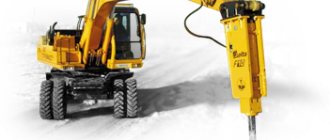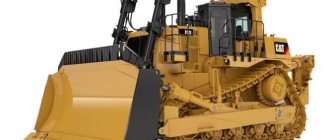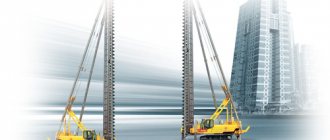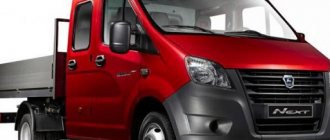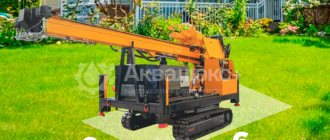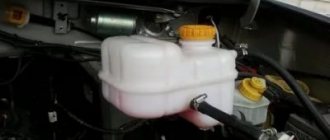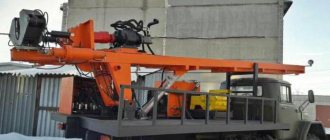A construction pile driving machine is a specialized mechanism that allows you to drive reinforced concrete or metal supports to a certain depth. Upon completion of installation, the pile heads are combined with a grillage, forming a reliable foundation base. Submerged supports perfectly compact the soil not only within the pile field, but also near it. Thanks to their use, large construction projects can be erected on soft soils. In addition to their main purpose, such machines are used to strengthen soil areas in the spaces between buildings under construction or for barrier fencing.
Application and purpose
The operational purpose of pile driver equipment is the installation of reinforced concrete piles and metal sheet piles. Such machines independently, without auxiliary installations, are capable of performing all technological processes for immersing the above structures. The operating cycle of piling equipment consists of the following stages:
- Relocation to the site;
- Placement at the dive point according to a pre-marked diagram;
- Pulling up the submerged structure with a winch;
- Installation of a pile or sheet pile in the driving position;
- Fixing the structure on the piledriver mast and docking it with the hammer;
- Driving piles;
- Undocking the pile and hammer;
- Moving equipment to the next dive point.
Fig : Driving reinforced concrete piles
Pile driving equipment is widely in demand in residential and industrial construction, where it is used for driving piles when constructing pile foundations for high-rise and low-rise buildings. This technique is also used;
- For installation of bridge supports (road and railway);
- For installation of piles in the foundations of hydraulic structures (berths, piers);
- For installation of power line supports, lighting poles.
Fig : Driving a tongue and groove
In order to install sheet piling metal, piling equipment is used to enclose pits with sheet piling walls, strengthen coastlines, unstable terrain, and create hermetically sealed reservoirs in the ground.
Important : there is a separate class of drilling and piling rigs that are capable of implementing two types of technological operations - driving piles or sheet piles and drilling wells. Such pile drivers are most often used for the purpose of installing piles using the leader drilling method.
What mechanisms are needed to build a foundation from cast-in-place piles?
The cast-in-place technology consists of preliminary drilling of wells in the ground (pile shaft), manufacturing and installation of a spatial frame made of reinforcing steel, and filling the shaft with concrete mixture.
Protection of the well walls is ensured by the immersion of special casing pipes (non-removable or retrievable).
To protect the walls of wells, a clay solution is used, which is pumped into the well under pressure by special pumps.
Mechanisms for foundations made of cast-in-place piles with walls secured with clay mortar
To carry out work on constructing a reliable foundation from bored piles with the walls secured with clay mash, special construction machines are required.
Preliminary drilling of wells is carried out in two ways: impact or rotational; rock layers, if any at the construction site, help overcome replaceable impact-type working bodies (bits and grabs).
A clay solution is pumped into finished wells, which helps strengthen the walls of the well and prevents rock collapse. To prepare the clay composition, special pumps, clay mixers, and settling tanks are used. The concrete solution is pumped into the pile body through a concrete casting pipe.
Our piling equipment
Our company has one of the most extensive fleets of piling equipment among private construction companies in Moscow. To carry out piling work we use:
- SP-49;
- UMMC-12;
- USA;
- BM-811;
- Junttan PM-20.
Let's look at each of the above pile drivers in more detail.
Fig : Junttan PM-20
Junttan PM-20 is a pile driver on a tracked transport base. Unlike other units, the PM-20 is equipped with a hydraulic hammer with higher efficiency than diesel units. The weight of the impact part of this hammer is 5 tons, which allows it to drive piles and sheet piling into high-hard soil (including permafrost) without the use of auxiliary technologies (drilling leaders or undermining). Among the operational advantages of the equipment are a rotating working platform and the possibility of spatial adjustment of the piledriver mast, which allows driving inclined piles (up to 18 degrees of deviation). PM-20 works with piles up to 14 m in length and weighing up to 3.5 tons. The cross-section of submerged structures is from 30x30 to 40x40 cm.
Fig : SP-49
SP-49 is a tracked pile driver, which uses the T170 tractor as a transport base. This installation is characterized by its compact size and high mobility within the construction site. The pile driver is equipped with a diesel-type hammer, the mass of the impact part of which is 2.5 tons. The equipment drives piles weighing 5 tons (length up to 12 m), the range of working sections is 30x30 and 35x35 cm. Like the PM-20, the machine is capable of driving inclined piles (18 degrees of deflection).
Fig : Universal pile-driving unit
USA , also known as the “Universal Piling Unit”, is a mobile wheeled pile driver that we use for installing pile fields under low-rise buildings and driving free-standing pile supports. The USA is equipped with a diesel hammer, the hammer of which weighs 1.25 tons. This hammer allows the pile driver to drive structures weighing 3 tons (length up to 12 m). The machine works with a pile section of 30x30 cm.
Fig : UMMC-12
UMMC-12 is a high-cross-country wheeled pile driver. The equipment is equipped with an all-wheel drive base (6x6) from Kamaz-53228, which effectively overcomes difficult rough terrain and works on sites where other types of piledrivers cannot reach. The pile driver has on board a diesel hammer with a striker weighing 3 tons. He drives piles weighing 5 tons (length up to 12 m). The range of sections is from 30x30 to 35x35 cm. The pile driver drives inclined piles (up to 12 degrees of deviation).
Fig : BM-811
BM-811 is a drilling and pile driving type pile driver . The equipment is capable of drilling wells (length up to 12 meters, diameter 15-50 cm) and driving piles into them (weight up to 3 tons, length up to 12 m). The installation does not require a change in configuration to perform these technical operations, which significantly reduces the implementation time and financial costs of the project (compared to the use of two separate piledrivers). The above types of pile drivers differ in terms of productivity:
- JunttanPM-20 drives up to 60 piles per day;
- SP-49 - up to 35 piles;
- USA and UMMC-12 up to 25 piles.
Important : we select a specific installation based on the working conditions - for the implementation of large projects we use PM-20 or SP-49, for the production of a small amount of work - USA and UMMC-12.
Hand pile driver
The prototype of all modern headframes is the now obsolete wooden manual one with a hanging head. In manual mechanical ones (Fig. 1), which is the first improvement of a hand-held projectile, a woman weighing up to 1,000 kg is lifted by workers to a height of up to 4 m using a winch or a manual winch. In this case, one worker is placed on 75-100 kg of the woman being lifted.
In this type of copra, the woman is hooked onto the end of the rope that lifts her using a special device called a “cat” (Fig. 2). After rising to the required height, the woman is unhooked from the cat by pulling the rope tied to the latter, and she freely falls onto the pile. The cat, under the influence of its own weight (sometimes reinforced by additional weight), follows the woman, unwinding the rope from the gate or winch, for which the latter have an idle speed. Having overtaken the woman who had stopped from hitting the pile, the cat hooks her again for the next ascent.
In most modern pile drivers, the suspended head is lifted by a steam or electric winch.
Standard wooden one - with a suspended detachable hoist weighing 1.10 tons, lifted by a friction-geared electric winch. The head of this K. moves either directly along the booms or along special guides made of channels inserted between them, which can be moved along the booms with a 0.5 HP manual winch. If necessary, such “telescopic” channels are lowered below the base. The pile driver moves both on wheels along a rail track and on rollers rotated by crowbars threaded through them.
In the European type, the baba is usually placed in front of the arrows. In most American ones, it is placed between the arrows. In this case, a more complex but automatic design is used to hook the woman. In it, pincers compressed by a strong spring grab the woman’s arrow-shaped or triangular ear from the sides and lift the latter to the required height, where the upper ends of the pincers unclench, meeting the stops attached to the arrows.
When falling back onto the woman, the lower ends of the pincers unclench from the impact on the woman’s triangular ear and grab the latter for a new rise. To regulate this rise, the stops are sometimes made of metal, moving on a cable along arrows.
Baba Lakura and Artsisha
Of the baba currently in use, the most simple are the baba Lakura (Fig. 3) and the frequently encountered baba Artsisa. Both women refer to single-acting (simple) steam hammers, in which the impact moving part is a steam cylinder, which contains a piston with a rod passed through the bottom of the cylinder. The rod, with its end pointed in the center, rests against the pile, all the time transferring to the latter the load from the weight of the woman.
Steam is released into the upper part of the cylinder located above the piston. In Baba Lakura, steam is supplied through a side hole in the cylinder head; it houses a steam distribution device consisting of a rotary valve with 3 holes and a switch lever. When the tap is in position 1 (Fig. 4), steam is directed into the cylinder, lifting it above the stationary piston, but after turning the tap to position II, the steam leaves the cylinder into the atmosphere, and the cylinder falls, hitting the woman. In another design, steam is introduced through the top of a special hollow rod, which is a continuation of the main piston rod. This rod passes through the cylinder head and in its upper part contains a spool steam distribution device.
In the USA, the automatic single-acting Warrington system is widely used. The cylinder of this woman is connected by two side channels and four massive bolts to the lower part of the projectile, which serves as the head of the pile being driven. Between this head and the cylinder there is a special heavy striker connected to the cylinder piston moving up and down. This striker is the striking part of the woman. The blower is equipped with an automatically operating steam distribution, as a result of which it can make 50-80 blows per minute. Warington's Baba works with both steam and compressed air. All of the steam towers described above are usually serviced by wooden headframes, the systems of which have been developed and standardized in detail by many companies.
Use of wooden piledrivers
The use of wooden pile drivers is convenient due to the possibility of their rapid production on the job with standard metal parts available. In an ordinary wooden frame of a Lakura woman, steam is supplied through a pipeline with swivel joints and a flexible hose at the end, allowing the woman to move when driving. The pipeline hangs on a cable attached at its other end to the pile after being thrown over two blocks, due to which the suspended pipeline is lowered along with the pile being driven. If it is necessary to drive inclined piles, they make a special one with inclined arrows or resort to a pendulum pile driver. (Fig. 5).
Pile driving equipment: attachments
For driving piles, hammers are used, which can vary in operating principle:
- mechanical
- steam-air
- hydraulic
- diesel hammers
With the development of technology for driving piles, the first two types of hammers have now practically disappeared from the staff of construction enterprises. Hydraulic hammers are the most powerful attachments used for tracked or rail mounted pile drivers. Such pile-driving installations are used in the construction of large, massive buildings and structures.
Our company is focused on the construction of small and medium-sized objects, so we use UR-1250 tubular diesel hammers, which allow us to drive piles not only vertically, but also at an angle to the horizon. May be useful for you:
- Pile driving machine
- Yuntang pile driving rig
Classification of piledrivers
Copras are classified according to their operating principle:
- suspended hammers - units operate on the principle of free fall, performing up to 10 beats/min. Diesel and steam driven mechanisms are mounted on a frame or attached to an excavator;
- steam-air hammers - a unit with a pneumatic drive operates in semi-automatic mode. The impactor is a cylindrical installation that determines the height of the fall. The productivity of the equipment reaches 60 beats/min;
- diesel hammers - a cylindrical body moves along a pair of guides and with its lower end strikes a pile driven into the ground. The driving force is the explosive reaction of the combustible mixture located in the cylinder. The productivity of such equipment reaches 100 beats/min.
- impact mechanisms (high-speed) - the impact link is fixed directly on the pile. Thanks to the energy of the steam, the hammer piston is lowered and raised. The productivity of such installations reaches 230 beats/min;
- electric vibrating hammer - torque is created through a belt drive driving flywheels using an electric motor;
- vibro-impact hammers - a combination of impact and vibration loads allows you to achieve a productivity of 1500 beats/min.
May be useful for you:
|
|
Piling equipment: benefits of a pile driver on wheels
A pile driver based on a KrAZ 250 vehicle with a rotary platform is much more mobile and preferable where relatively small buildings are being erected and the use of heavy equipment is impractical. It combines the advantages of a truck-mounted and a track-mounted pile driver and is the most versatile and high-performance machine available.
Such a pile driver is especially effective in the construction of the following objects:
- pile foundations for cottages
- warehouses, hangars and other industrial facilities, especially in conditions of weak, soft soils
- industrial building
- low-rise country houses
- power poles
- masts for mobile operators
- other objects where the installation of a pile foundation is the most acceptable option
Types of pile elements
The production of pile elements is carried out in production conditions, on the construction site. Metal and reinforced concrete elements are produced ready for use. It is necessary to organize the transportation of equipment, loading and unloading to the destination. The driving of such supports into the earth's cavity is carried out by construction units and mechanisms. Pile structures can be made with your own hands. A well is created to match the diameter of the pile. Its cavity is filled with concrete.
Pile elements are divided into categories:
- driven - rods made of reinforced concrete. Rarely used for independent construction. High cost of renting technical equipment. The piles themselves are also expensive. Calculations are carried out in advance: immersion depth, impact force and operating time of the pneumatic construction hammer;
Driven supports
- screw. Made of metal. Recommended for low-rise buildings. The introduction of a screw support is possible using your own resources and equipment;
- bored A borehole is drilled into the ground with a drill. The cavity is filled with concrete.
Relocation conditions
ready to relocate piling equipment to any point in the Moscow region. We offer the lowest prices among competing organizations:
- Wheeled pile drivers: within zone No. 1 - up to 20 tr., within zone No. 2 - 25 tr.
- Crawler pile drivers: zones No. 1 and No. 2 - 80 tr.
Figure : Pile driver relocation zones
We are ready to significantly expand the coverage of the territory - if you are interested in relocating piledrivers outside the above zones, agree on its cost with the company’s managers.
Read more about the terms of delivery of our equipment to your site: Relocation of piling equipment.
Important : the reason for the higher price for relocating tracked pile drivers is the need to attract additional equipment to transport them, while wheeled pile drivers move along roads independently.
Advantages of renting equipment from us
has a reputation as one of the leading Moscow construction companies specializing in piling work.
We bring to your attention the main factors that make cooperation with our company productive and mutually beneficial:
- modern piling equipment at our disposal - we have all the necessary equipment to effectively perform the entire range of piling work;
- The main emphasis in our activities is on quality and efficiency - we never exceed the deadlines allotted for the implementation of the project and do everything with the highest possible quality;
- All of our employees, from designers to operators of pile drivers, have extensive experience and are highly qualified ;
- We give you the opportunity to save - our prices for the main types of piling work are an order of magnitude lower than those of our competitors.
Rent of equipment for driving piles
If you are a representative of a construction company and need to carry out piling work, renting piling equipment in Moscow and the region will solve your problems. Moving quickly between objects, our piling and drilling machines will complete the entire required amount of work in the shortest possible time.
High professional training and strong discipline of our company’s piling equipment personnel is a guarantee of quality and timely completion of any piling work. The prices are not expensive.
Contact us and we will do the work
- Our video experience
- Our contacts for ordering work
Our company supplies piling equipment - contact us, we will help!
Useful materials
Piles for driving piles
A pile driver is a machine for driving reinforced concrete piles and sheet piles using the method of impact driving or vibration.
Pile driving installations
Driving piles using the impact method is carried out by driving piles with hammers.
No. 3. Vibro-impact method
As the name suggests, this method involves a combination of vibration and shock loading. The pile is simultaneously affected by both vibrations and impacts, which allows it to quickly and relatively easily enter the soil. This method is used on dense soils , where another method will be ineffective.
The installation, which carries out vibroimpact driving, has two frames: on one there is an electric generating impact apparatus, on the second there is a boom with a vibratory driver. The vibrator is connected to the pile using a head, then the pile is positioned and the mechanism is started. , piles up to 6 m long can be driven
How do you drive piles into the soil?
The screw and bored type of rods requires the use of large-sized construction equipment. It is impossible to insert driving elements into the soil cavity with your own hands. The mechanism is used. Machines are used on caterpillar tracks or on wheels.
Tracked mechanisms cannot always get to the construction site. Organize the order of the trawl. Additional investments are required. Wheeled units are characterized by mobility. The process of using them is economical when compared with the previous option.
Pile driving technology
Technical construction equipment differs in the method of immersion:
- Pile driver. The mechanism of operation is striking the pile support with a hammer. The hydraulic hammer is powered by a drive. Impact force can be adjusted. The diesel analog works by burning diesel fuel.
- Pile pressing units. They are distinguished by the smooth pressing of the supports into the ground. The blows are performed at the end of the dive, when the rod reaches dense soil layers. The use of equipment near residential buildings is permitted.
- Vibrator. It is typical to create vibration along the axis of the pile element. The unit can be powered by an electric motor or a hydraulic drive.
Vibrator
Driving piles
Stages of support immersion:
- You first need to prepare the reinforced concrete product. It is installed in a vertical position for driving in.
- Indentation of the rod element.
- Applying precise blows to the pile until it is completely immersed.
